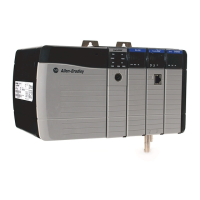Rockwell Automation Publication 1756-RM003N-EN-P - October 2011 423
Array (File)/Shift Instructions (BSL, BSR, FFL, FFU, LFL, LFU) Chapter 9
CONTROL Structure
Description: Use the LFL instruction with the LFU instruction to store and retrieve data in a
last-in/first-out order. When used in pairs, the LFL and LFU instructions
establish an asynchronous shift register.
Typically, the Source and the LIFO are the same data type.
When enabled, the LFL instruction loads the Source value into the position in
the LIFO identified by the .POS value. The instruction loads one value each time
the instruction is enabled, until the LIFO is full.
Arithmetic Status Flags: Not affected
Fault Conditions:
Mnemonic Data Type Description:
.EN BOOL The enable bit indicates that the LFL instruction is enabled.
.DN BOOL The done bit is set to indicate that the LIFO is full (.POS = .LEN). The .DN bit inhibits loading
the LIFO until .POS < .LEN.
.EM BOOL The empty bit indicates that the LIFO is empty. If .LEN ≤ 0 or .POS < 0, both the .EM bit and
.DN bit are set.
.LEN DINT The length specifies the maximum number of elements the LIFO can hold at one time.
.POS DINT The position identifies the location in the LIFO where the instruction will load the next value.
You must test and confirm that the instruction doesn’t
change data that you don’t want it to change.
The LFL instruction operates on contiguous memory. In
some cases, the instruction loads data past the array into
other members of the tag. This happens if the length is too
big and the tag is a user-defined data type.
A major fault will occur if Fault type Fault code
(starting element + .POS) > LIFO array size 4 20

